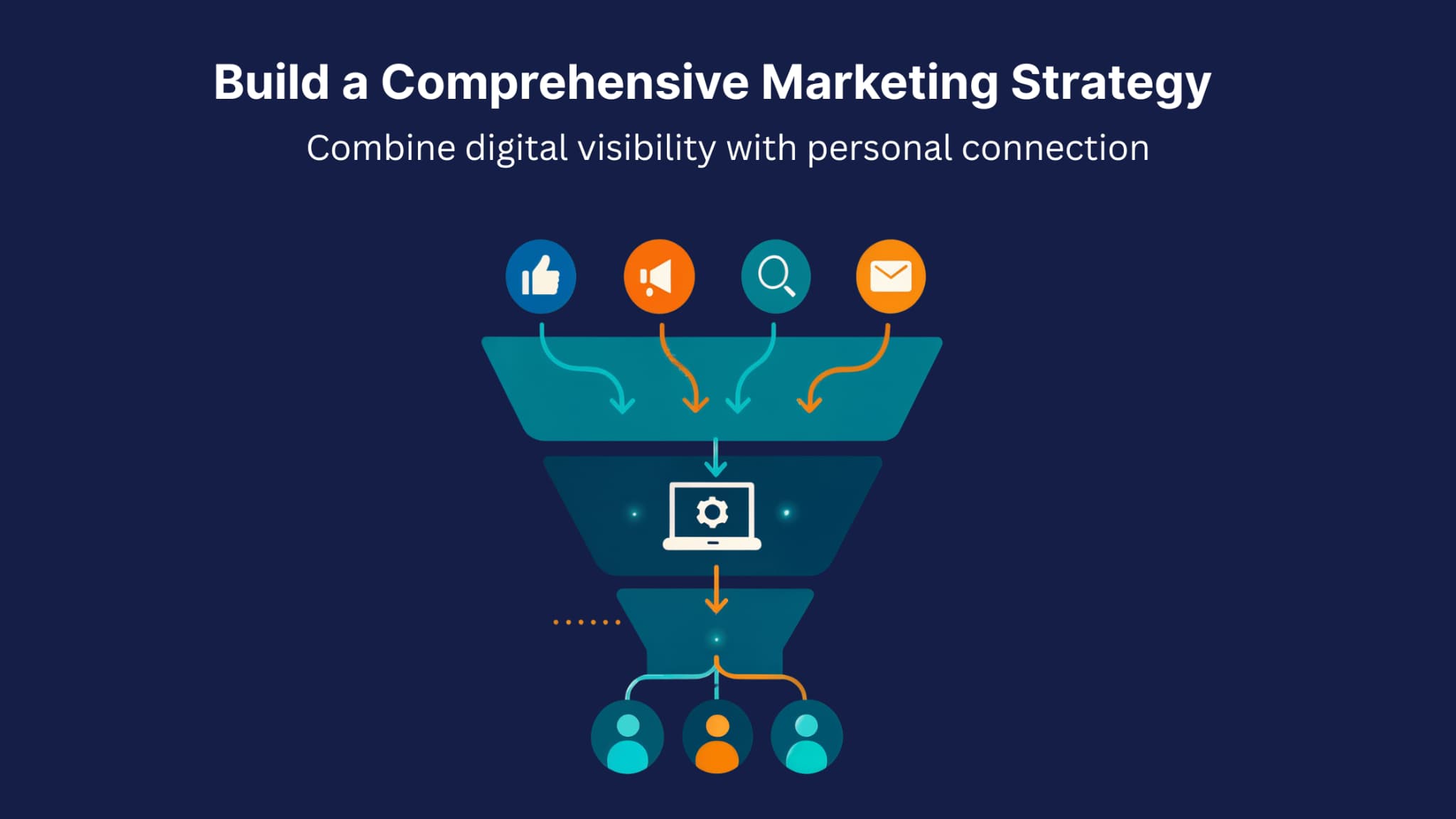10 Proven Strategies Franchisors Use to Fill Their Sales Pipeline
by

- 1. Build a Comprehensive Marketing Strategy
- 2. Target the Right Audience with Precision
- 3. Leverage Your Existing Franchise Network
- 4. Diversify Your Outreach Methods
- 5. Perfect Your Franchise Sales Presentation
- 6. Use Social Media to Build Awareness and Trust
- 7. Create a Defined Franchise Sales Process
- 8. Strengthen Your Online Presence with SEO and Content
- 9. Be Proactive, Don’t Wait for Leads to Come to You
- 10. Use Lead Generation Portals and Tools Wisely
- How a Franchise-Specific CRM Keeps Everything in Sync
- Conclusion: Build a Franchise Sales System That Lasts
- FAQs
The challenge is not usually finding opportunities but rather managing the opportunities well. When your marketing, outreach, and follow-ups work together, growth feels less like a guessing game and more like a steady, reliable process.
This guide covers ten real-world strategies franchisors use every day to build and maintain successful pipelines. Each one is practical, proven, and easy to adapt to your business. With the right systems, like Pulse CRM, you can make your process smoother and more consistent without adding more work.

1. Build a Comprehensive Marketing Strategy
If people don’t know about your franchise, they can’t become part of it. A strong marketing strategy goes beyond ads and clicks. It’s about building trust and staying visible in meaningful ways. The best franchisors combine digital tools with personal connections, creating a mix that builds genuine engagement.
Key Steps:
- Maintain a consistent presence on Google, LinkedIn, and franchise portals, and stay active in your local business community.
- Keep your message personal and simple. Focus on independence, growth, and support.
- Mix online efforts with real-world activities like discovery days and networking events.
Once your marketing efforts are running smoothly, the next step is finding ways to make them more consistent and efficient. That’s where marketing automation comes in. Before diving into the results, it helps to understand how marketing automation fits into a franchise strategy.
Automation isn’t just about sending emails or setting reminders. It’s about creating consistency in how you engage with potential franchisees, ensuring no lead slips through the cracks. By using automation, franchisors can maintain momentum, respond faster, and deliver a more personalized experience without overloading their teams.
Quick Comparison: Before vs. After Marketing Automation
| Scenario | Before Automation | After Automation |
|---|---|---|
|
Lead response time |
2–3 days |
Under 5 Minutes |
|
Follow-up consistency |
Irregular |
100% tracked |
|
Conversion rate |
10% |
19–24% |
Set up automatic responses for new leads from ads or inquiries. One franchise that did this saw response times drop dramatically, freeing their team to focus on their qualified leads instead of manual follow-ups.
Great marketing starts with understanding where your ideal candidates spend time and how they make decisions. Instead of trying to be everywhere, invest in a few key channels that generate real engagement. For example, Google Ads and franchise portals work best when paired with follow-up content that reinforces your brand’s message.
Think of marketing as a conversation, not a campaign that ends with a click. Use remarketing tools to stay in front of people who’ve visited your site, and build email sequences that answer their questions over time. Franchisors who treat marketing as a long-term system, not a short-term push, see more predictable results.
Review your marketing every quarter using Pulse Reporting. This helps you identify which channels bring the most qualified leads and where your message truly resonates. The clearer your focus, the more naturally you’ll attract the right people.
For additional resources, explore the International Franchise Association.
2. Target the Right Audience with Precision
When your marketing starts working, it’s easy to get excited about every lead—but not every lead is the right fit. Strong pipelines are built on quality, not volume. Knowing exactly who you want to reach saves time, money, and energy.
Practical Tips:
- Outline your ideal franchisee—where they live, what drives them, and what kind of business experience they have.
- Use CRM tags to organize leads by type, such as Investor, Multi-Unit Buyer, or First-Time Owner.
- Tailor your messages so each contact feels personal and relevant.
Targeting the right audience goes beyond demographics. It’s about understanding personality, motivation, and mindset. Someone looking for a hands-on business experience won’t connect with messaging aimed at investors looking to earn passive income. The more your outreach speaks to their goals, the faster they’ll see themselves in your opportunity.
Start by studying your top-performing franchisees. What do they have in common? Their background, management style, or even their work habits might offer clues about who’s most likely to succeed. Once you’ve identified those patterns, create content and communication that appeal to those strengths.
Segmenting your audience also prevents wasted effort. Leads in early research stages may need education, while ready buyers want clear next steps. Personalized communication keeps both groups engaged.

3. Leverage Your Existing Franchise Network
Your current franchisees are your strongest ambassadors. They’ve lived the experience your prospects are curious about, and their stories carry more weight than any marketing message.
Ways to Leverage Your Network:
- Offer simple referral incentives and make it easy for franchisees to share leads.
- Encourage owners to post authentic videos or testimonials about their journey.
- Host live Q&A sessions so prospects can hear real stories directly from franchisees.
Word-of-mouth is still one of the most powerful growth drivers in franchising. According to Nielsen, 88% of people trust recommendations from people they know more than any form of advertising. Prospects naturally trust the people already thriving in your franchise system.
You can also strengthen relationships within your network by fostering collaboration. Create private groups or regional meetups where franchisees can exchange insights. This builds community and shows new prospects that your system supports long-term success.
4. Diversify Your Outreach Methods
Once your network starts generating referrals, it’s time to expand your reach. Prospective franchisees use a variety of channels to research opportunities, so you need to meet them where they are.
Top Outreach Channels:
- Email sequences that educate and build interest.
- Webinars and discovery sessions that create personal connections.
- Industry events, expos, and trade shows are where trust can form quickly.
Try using marketing automation to connect your outreach channels. When each touchpoint, such as an email click, event signup, or website visit, automatically triggers the next step, your communication feels seamless and thoughtful.
Outreach Efficiency Summary
| Channel | Automation Benefit | Engagement Outcome |
|---|---|---|
|
|
Timely follow-ups |
3x response rate |
|
Webinars |
Auto reminders |
Higher attendance |
|
Events |
Instant follow-up |
More booked calls |
Diversifying your outreach isn’t just about adding more tools or channels. It’s about finding the right mix that fits your audience and making sure each platform plays a meaningful role in how you connect with potential franchisees. It’s about understanding how each channel contributes to your lead journey. For instance, email helps nurture prospects over time, while social media builds visibility and trust. Industry events and webinars, on the other hand, create personal connections that help people make confident decisions.
Keep your message consistent, but adjust your tone for each platform. Short, conversational posts may work best on social media, while in-depth insights might perform better in newsletters. According to McKinsey & Company, using a mix of outreach methods can increase conversions by up to 20%.
A unified strategy makes every touchpoint more effective. Plan your campaigns with a content calendar and use Pulse Marketing Reports to analyze which outreach methods generate the most qualified leads.
Let Us Help You Get Started!
Pulse CRM delivers more than software. We’re your partner in success.
We fully set up your CRM, including importing your data, configuring sales and marketing automations, designing branded email templates, writing engaging email copy, setting up sales pipelines, and much more.
5. Perfect Your Franchise Sales Presentation
When a prospect finally engages, your presentation becomes your most powerful tool. It’s your chance to connect emotionally and logically. Facts build confidence, but stories build belief.
Key Presentation Essentials:
- Start with your mission and what makes your culture special.
- Balance data with personal stories from real franchisees.
- End with clear, natural next steps.
Think of your presentation as a guided conversation, not a pitch. Address the questions people are already asking themselves. What kind of support will they receive, and what kind of lifestyle can they expect? The more you make them feel understood, the easier it becomes for them to picture joining your franchise.
A great presentation finds the balance between data and emotion. You want prospects to walk away thinking, “This feels right, and the numbers make sense.” According to Forbes, blending both can significantly improve audience engagement.
Practice makes perfect here. Keep your tone conversational, not rehearsed. Add visuals or short examples that help explain key points, like what the first 90 days as a new owner look like. When you create a genuine, two-way dialogue, your presentation feels approachable, memorable, and trustworthy.

6. Use Social Media to Build Awareness and Trust
Social media gives potential owners an inside look at what makes your franchise unique. They’re not just paying attention to what you sell; they’re observing how you treat people, how you communicate, and how you show up every day.
Practical Ideas:
- Highlight franchisee wins, team moments, and meaningful milestones.
- Post short, behind-the-scenes clips that show your team’s personality and daily rhythm.
- Reply to comments and questions directly, and always thank people for engaging.
Focus on showing the human side of your business. Share genuine moments from your franchise community, like owners celebrating small wins or supporting one another through challenges. When you respond in real time, it creates a sense of community and shows that your brand is run by real people, not just managed accounts.
Social media has become one of the most powerful ways to build trust. It’s not about chasing followers, it’s about starting honest, two-way conversations that reflect your values. Prospects want to get a sense of what it feels like to join your network long before they apply. That’s why casual behind-the-scenes videos, short interviews with franchise owners, and authentic customer stories resonate as they help potential partners connect on a personal level.
Consistency is key. Focus on posting meaningful updates instead of flooding your feed with generic content. A few thoughtful posts that spotlight your team, culture, or local involvement will always perform better than a long list of impersonal announcements.

7. Create a Defined Franchise Sales Process
Once your social presence starts bringing in interest, that’s when structure becomes your safety net. Without a clear process, even the most promising leads can slip away. A defined sales process helps your team stay steady and confident, knowing exactly what to do next and how to keep conversations moving forward.
Example Stages:
- Initial Inquiry
- Discovery Call
- Application
- Franchise Disclosure Document (FDD)
- Financial Verification
- Discovery Day
- Won Deal
- Lost Deal
Benefits of a Defined Process:
- Predictable follow-ups that show professionalism and care.
- A clear view of every lead’s progress so nothing gets missed.
- Fewer delays, smoother communication, and more consistent results.
One franchisor who used sales pipeline automation cut their average close time by 22% just by creating simple automatoins to ensure leads were always progressing forward. A process doesn’t just make your sales team more organized because it makes prospects feel like your franchise is reliable and thoughtfully managed.
A defined sales process keeps everyone aligned. Your team knows when to step in, what to send, and how to guide leads naturally from one step to the next. This predictability reduces confusion, prevents stalled conversations, and helps identify where things slow down before they become problems.
A consistent system also makes it easier to maintain quality across locations and team changes. Whether a new development manager joins or a veteran takes a vacation, a documented process ensures every lead receives the same level of care. The Harvard Business Review found that structured sales systems can boost performance by nearly 30%, mainly because they minimize guesswork and improve accountability.
When mapping out your process, think about it from the lead’s perspective. What does an ideal journey feel like? From the first inquiry to the final agreement, outline each step and touchpoint so that communication feels natural and personal. Keep it simple enough that your team can follow it easily, but flexible enough to adapt to each conversation.
8. Strengthen Your Online Presence with SEO and Content
Now that your process is running smoothly, your online content can take on more of the work. These days, most franchise candidates spend time researching quietly before they ever reach out. Your content is often their first real experience with your brand, so it should guide them, reassure them, and give them reasons to trust you.
Create Content That Converts:
- Write blogs that answer real questions from franchise buyers in plain language.
- Share case studies that highlight wins and lessons learned, not just numbers.
- Publish comparison guides that help readers make smart, confident choices.
Think of your content like a friendly chat over coffee, where you’re genuinely trying to help someone make a big decision. The best-performing posts usually come from honest, thoughtful insights that speak to what people are really wondering about. For example, a franchise-focused article titled “What I Wish I Knew Before Buying a Franchise” offered candid, real-world advice instead of polished sales talk.
It was simple, practical, and down-to-earth, and that authenticity struck a chord with readers. People remember content that helps them make sense of something complex, not content that tries too hard to sell them on an idea.
Keep an eye on what resonates most. Use Google Analytics to see which articles and topics keep readers engaged, and then build more around those themes.
Your online presence is your digital handshake, as it sets the tone for what people expect from you. Each article, video, or resource should leave prospects feeling more confident and curious about what’s next. Visual tools like short videos, infographics, or franchise cost calculators make information easier to digest and feel more personal.
Good SEO ensures your helpful content actually gets found. Focus on using the language your audience uses, not corporate buzzwords. And remember, consistency builds connection.
Keep your tone friendly and conversational across all platforms. The goal is for prospects to feel like they’re learning from a trusted partner, not reading another brochure.
9. Be Proactive, Don’t Wait for Leads to Come to You
Even with strong content, successful franchisors don’t just sit back and wait. They take initiative, start meaningful conversations, and make sure potential franchisees feel seen and supported. Being proactive isn’t about pushing people. It's about staying present and showing genuine curiosity about their needs.
Outreach Blueprint:
- Reach out to past leads at moments that make sense for them.
- Send short, thoughtful notes instead of generic follow-ups.
- Use reminders to ensure no lead slips through the cracks.
When a franchise uses Pulse for Franchises and sets up smart email and text message automations tailored to the customer journey, it turns quiet leads into active conversations again. When you reach out with good timing and intention, it shows people you’re paying attention.
Proactive Outreach Impact
| Metric | Before Automation | After Automation |
|---|---|---|
|
Follow-up rate |
45% |
92% |
|
Lead-to-call conversion |
22%
|
35% |
|
Response Time After Initial Inquiry |
2-3 days |
Under 5 minutes |
Building a reputation for quick, personal responses can turn more “maybes” into “yeses.” Every timely check-in reminds prospects that you value their interest. Instead of overwhelming them with messages, focus on being consistent, approachable, and easy to reach. A quick thank-you, a helpful article, or a check-in after a webinar can go a long way in showing reliability.
Consistency matters most. Plan regular touchpoints based on how each lead behaves and where they are in your sales pipeline. For example, a lead who downloaded an eBook might appreciate a short email with a related tip, while someone who attended a webinar might be ready for a discovery call. This natural flow keeps communication relevant and personal.
Data can help guide this process, too. Gartner found that responding within the first hour of engagement can raise response rates by nearly 40%. Acting fast signals that you care about their time and interest. The key is to show up when it matters most and follow through every time.
Being proactive isn’t about constant chasing. It’s about timing, empathy, and thoughtful communication that keep relationships moving forward.
10. Use Lead Generation Portals and Tools Wisely
When your proactive efforts are running smoothly, you can explore additional options like portals and lead generation platforms. These tools can be helpful, but they only work well if you know how to manage them with intention and care.
Smart Portal Management Steps:
- Test different platforms and track which ones bring genuinely interested prospects.
- Label leads by source and keep tabs on how many turn into actual deals and sales.
- Use automation to respond quickly and keep new inquiries from going cold.
A home service franchise discovered through reporting that the marketing strategy they thought was their best performer was actually their weakest. They had been relying on spreadsheets and assumptions, which made it hard to spot the problem.
When they switched to real-time reporting, the data showed they were losing about $10,000 a month on underperforming campaigns. That discovery allowed them to reallocate those funds toward their strongest marketing channel, increasing qualified leads almost immediately.
This is exactly why having live, accurate insights can make a measurable difference and allow you to make smart, educated decisions.
Lead Source ROI Snapshot
| Channel | Avg. Conversion Rate | Cost Efficiency |
|---|---|---|
|
Franchise Portals |
8% |
Moderate |
|
Paid Ads |
15% |
High |
|
Referrals |
25% |
Very High |
When you take the time to evaluate your sources, you’ll spend less time chasing volume and more time building connections that matter. Lead generation portals can play a supporting role in your marketing strategy, but only if you use them wisely. Not every platform brings high-quality leads, and some may attract people who are just exploring ideas rather than ready to invest.
Think of each portal as an experiment. Start small, observe how leads engage, and compare the quality of conversations over time. Look beyond vanity metrics like total submissions and focus on sales pipeline metrics that tell a better story about the lead. These clues reveal which channels truly bring serious buyers.
Finally, keep your lead mix balanced. Pair paid listings with referrals, organic search, and local partnerships to stay resilient if one source slows down. This practical, steady approach helps franchisors spend smarter and focus their energy on relationships that actually move the business forward.
Let Us Help You Get Started!
Pulse CRM delivers more than software. We’re your partner in success.
We fully set up your CRM, including importing your data, configuring sales and marketing automations, designing branded email templates, writing engaging email copy, setting up sales pipelines, and much more.
How a Franchise-Specific CRM Keeps Everything in Sync
By this point, you’ve got strategies across marketing, outreach, and communication. Now it’s time to connect them. A franchise-specific CRM keeps all your moving parts working in sync so your team stays focused on people, not paperwork.
Franchise CRM Benefits by Role
| Role | Challenge | CRM Benefit |
|---|---|---|
|
Franchisor |
Managing multiple territories |
Real-time oversight |
|
Sales Rep |
Staying on top of follow-ups |
Automated reminders |
|
Marketing |
Measuring what’s working |
Easy reporting |
When everyone sees the same data, your conversations feel smoother and your pipeline runs stronger.

Conclusion: Build a Franchise Sales System That Lasts
Each of these strategies works together to build something bigger, a franchise system that runs smoothly because it has processes in place. The franchisors who grow steadily aren’t the loudest or flashiest; they’re the most consistent. They communicate clearly, follow up reliably, and make every lead feel valued.
Key Takeaways:
- Keep things simple and repeatable.
- Let automation support your relationships, not replace them.
- Every follow-up is a chance to show that you care.
When your systems work, your team can focus on what really counts: building relationships and growing your brand with confidence.
Ready to make your franchise pipeline smoother and more predictable? Book a 30-minute demo and see how Pulse CRM helps franchisors stay organized without losing the human touch.
FAQs
A franchise CRM handles layered pipelines and multiple territories. It connects teams and ensures consistent communication and visibility across the network. This matters because franchise operations often involve complex relationships between corporate and individual owners. Having one system helps everyone stay aligned, reduces miscommunication, and gives franchisors a real-time view of performance.
Automation saves time and ensures consistency across your sales process. It takes care of repetitive tasks like sending automated follow-ups, nurturing leads, or updating records so your team can focus on conversations that actually move deals forward. This approach not only prevents missed opportunities but also improves your speed of response.
Tracking key performance metrics gives you insight into how your sales process is performing and where adjustments are needed. Metrics like time-to-contact, lead-to-call conversion rate, and ROI by source help you identify bottlenecks and optimize resources. Regularly reviewing this data allows franchisors to spot trends early, such as which campaigns attract higher-quality leads. A franchise development team might discover that referral leads close faster than paid ads, leading them to reallocate marketing spend more efficiently.
As franchises grow, maintaining consistency across multiple territories becomes challenging. A centralized CRM system keeps data, communications, and performance tracking in one place, helping teams work more efficiently. This structure ensures that every new location starts with the same playbook and level of support.


